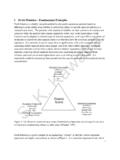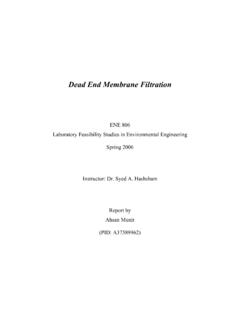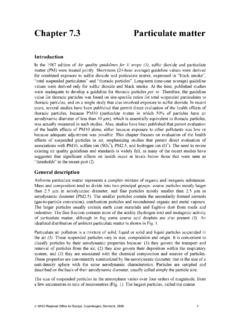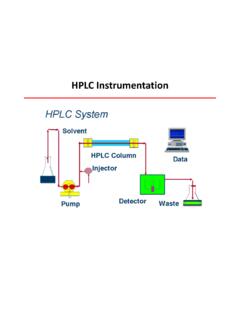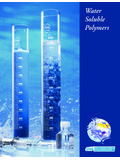Transcription of Fundamentals of Ion Exchange - Lenntech
1 Dow Liquid SeparationsFundamentals of Ion ExchangeBased on a paper by:R. M. Wheaton Dow Chemical J. Lefevre Dow Chemical Exchange Tel. + Fax. Tel. + Fax. +31-152-616-289 LenntechFundamentals of Ion ExchangeIon Exchange is the reversibleinterchange of ions between a solid(ion Exchange material) and a liquidin which there is no permanentchange in the structure of the Exchange is used in watertreatment and also provides a methodof separation in many non-waterprocesses. It has special utility inchemical synthesis, medical research,food processing, mining, agricultureand a variety of other utility of ion Exchange rests withthe ability to use and reuse the ionexchange material. For example, inwater softening:2 RNa++ Ca2+$R2Ca2++ 2Na+The exchanger R in the sodium ionform is able to Exchange for calciumand thus, to remove calcium fromhard water and replace it with anequivalent quantity of , the calcium loadedresin may be treated with a sodiumchloride solution, regenerating it backto the sodium form, so that it is readyfor another cycle of operation.
2 Theregeneration reaction is reversible;the ion exchanger is not permanentlychanged. Millions of liters of watermay be softened per cubic meter ofresin during an operating period ofmany Exchange occurs in a variety ofsubstances and it has been used onan industrial basis since circa 1910with the introduction of watersoftening using natural and later,synthetic zeolites. Sulfonated coal,developed for industrial watertreatment, was the first ion exchangematerial that was stable at low introduction of synthetic organicion Exchange resins in 1935 resultedfrom the synthesis[1]of phenoliccondensation products containingeither sulfonic or amine groups whichcould be used for the reversibleexchange of cations or variety of functional groups havebeen added to the condensation oraddition polymers used as thebackbone structures.
3 Porosity andparticle size have been controlled byconditions of polymerization anduniform particle size manufacturingtechnology. Physical and chemicalstability have been modified andimproved. As a result of theseadvances, the inorganic exchangers(mineral, greensand and zeolites)have been almost completelydisplaced by the resinous typesexcept for some analytical andspecialized applications. Syntheticzeolites are still used as Properties of ResinsConventional ion Exchange resinsconsists of a cross-linked polymermatrix with a relatively uniformdistribution of ion-active sitesthroughout the structure. A cationexchange resin with a negativelycharged matrix and exchangeablepositive ions (cations) is shown inFigure 1. Ion Exchange materials aresold as spheres or sometimesgranules with a specific size anduniformity to meet the needs of aparticular application.
4 The majorityare prepared in spherical (bead) form,either as conventional resin with apolydispersed particle size distributionfrom about mm to mm (50-16mesh) or as uniform particle sized(UPS) resin with all beads in a narrowparticle size range. In the water-swollen state, ion Exchange resinstypically show a specific gravity The bulk density as installedin a column includes a normal 35-40percent voids volume for a sphericalproduct. Bulk densities in the range of560-960 g/l (35-60 lb/ft3) are typicalfor wet resinous Properties of ResinsCapacity. Ion Exchange capacity maybe expressed in a number of capacity, , the total numberof sites available for Exchange , isnormally determined after convertingthe resin by chemical regenerationtechniques to a given ionic form.
5 Theion is then chemically removed from ameasured quantity of the resin andquantitatively determined in solutionby conventional analytical capacity is expressed on a dryweight, wet weight or wet volumeFigure 1. Cation Exchange Resin Schematic Showing NegativelyCharged Matrix and Exchangeable Positive Ionsbasis. The water uptake of a resinand therefore its wet weight and wetvolume capacities are dependent anthe nature of the polymer backboneas well as an the environment inwhich the sample is of dry weight and wetvolume capacities with cross-linkageare shown in Figure 2 for a capacity is a measure ofthe useful performance obtained withthe ion Exchange material when it isoperating in a column under aprescribed set of conditions.
6 It isdependent on a number of factorsincluding the inherent (total) capacityof the resin, the level of regeneration,the composition of solution treated,the flow rates through the column,temperature, particle size anddistribution. An example is shown inFigure 3 for the case of watersoftening with a standard sulfonicresin at several regenerant Water swelling of an ionexchanger is primarily a hydration ofthe fixed ionic groups and increaseswith an increase in capacity to thelimits imposed by the polymernetwork. Resin volumes change withconversion to ionic forms of differingdegrees of hydration; thus, for acation exchanger, there is a volumechange with the monovalent ionspecies, Li+> Na+> K+> Cs+> Ag+.With polyvalent ions, hydration isreduced by the cross-linking action;therefore, Na+> Ca2+> Al3+.
7 In moreconcentrated solutions, less water istaken up owing to greater osmoticpressure. Selectivity. Ion Exchange reactionsare reversible. By contacting a resinwith an excess of electrolyte (B+inthe following reaction), the resin canbe converted entirely to the desiredsalt form:RA++ B+!RB++A+However, with a limited quantity of B+in batch contact, a reproducibleequilibrium is established which isdependent an the proportions of A+and B+and on the selectivity of theFigure 2. Total Capacity vs. Cross-Linkage (Percent DVB) PolystyreneSulfonic Acid Resin, H+FormFigure 3. Operating Capacity vs. Regenerant Level for Sodium-CycleOperation, Sulfonic Acid Resinresin. The selectivity coefficient, KBA,for this reaction is given by:where m and refer to ionicconcentrations in solution and resinphase, respectively.
8 Resin selectivitycoefficients have been determined fora range of ionic species and relatedto H+for cations and OH for anions,which are assigned selectivity valuesof The speed with which ionexchange takes place. The ionexchange process involves diffusionthrough the film of solution that is inclose contact with the resins anddiffusion within the resin particle. Filmdiffusion is rate-controlling at lowconcentrations and particle diffusionis rate-controlling at highconcentrations. Whether film diffusionor particle diffusion is the rate-controlling mechanism, the particlesize of the resin also is a determiningfactor. Uniform particle sized resinsexhibit enhanced kinetic performancecompared to conventionalpolydispersed resins due to theabsence of kinetically slow Strong oxidizing agents,such as nitric or chromic acid, rapidlydegrade ion Exchange resins.
9 Slowerdegradation with oxygen and chlorinemay be induced catalytically. For thisreason, certain metal ions, forexample, iron, manganese andcopper, should be minimized in anoxidizing solution. With cationexchangers, attack is principally anthe polymer backbone. Highly cross-linked cation resins have an extendeduseful life because of the greatnumber of sites that must be attackedbefore swelling reduces the usefulvolume based capacity and producesunacceptable physical properties, forexample, crush strength reductionand pressure drop increase. Withanion exchangers, attack first occurson the more susceptible functionalgroups, leading to loss of totalcapacity and/or conversion of strongbase to weak base limits of thermal stability areimposed by the strength of thecarbon-nitrogen bond in the case ofanion resins.
10 This strength issensitive to pH and low pH enhancesstability. A temperature limitation of60 C (140 F) is recommended forhydroxide cycle operations. Cationresin stability also is dependent onpH; the stability to hydrolysis of thecarbon-sulfur bond diminishes with alowering of pH. They are much morestable than anions however and canbe operated up to 150 C (300 F).Resin Structure and ManufactureThe manufacture of ion exchangeresins involves the preparation of across-linked bead copolymer followedby sulfonation in the case of strongacid cation resins, orchloromethylation and the aminationof the copolymer for anion resins. Cation Exchange Resins. Weakacid cation Exchange resins arebased primarily an acrylic ormethacrylic acid that has been cross-linked with a di-functional monomer(usually divinylbenzene [DVB]).











